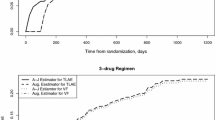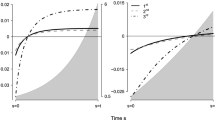Abstract
The prevalence of interval censored data is increasing in medical studies due to the growing use of biomarkers to define a disease progression endpoint. Interval censoring results from periodic monitoring of the progression status. For example, disease progression is established in the interval between the clinic visit where progression is recorded and the prior clinic visit where there was no evidence of disease progression. A methodology is proposed for estimation and inference on the regression coefficients in the Cox proportional hazards model with interval censored data. The methodology is based on estimating equations and uses an inverse probability weight to select event time pairs where the ordering is unambiguous. Simulations are performed to examine the finite sample properties of the estimate and a colon cancer data set is used to demonstrate its performance relative to the conventional partial likelihood estimate that ignores the interval censoring.
Similar content being viewed by others
References
Betensky RA, Lindsey JC, Ryan LM, Wand MP (2002) A local likelihood proportional hazards model for interval censored data. Stat Med 21: 263–275
Cheng SC, Wei LJ, Ying Z (1995) Analysis of transformation models with censored data. Biometrika 82: 835–845
Cox DR (1975) Partial likelihood. Biometrika 62: 269–276
Dabrowska DM, Doksum KA (1988) Partial likelihood in transformation models with censored data. Scand J Stat 15: 1–23
Fine JP, Ying Z, Wei LJ (1998) On the linear transformation model for censored data. Biometrika 85: 980–986
Finkelstein DM (1986) A proportional hazards model for interval-censored failure time data. Biometrics 42: 845–854
Goetghebeur E, Ryan L (2000) Semiparametric regression analysis of interval-censored data. Biometrics 56: 1139–1144
Gomez G, Calle ML, Oller R, Langohr K (2009) Tutorial on methods for interval-censored data and their implementation in R. Stat Model 9: 259–297
Henschel V, Heiss C, Mansmann U (2009) Intcox: compendium to apply the iterative convex minorant algorithm to interval censored event data. http://127.0.0.1:21646/library/intcox/vignettes/intcox.pdf. Accessed 8 Feb 2010
Huang J, Wellner JA (1997) Interval censored survival data: a review of recent progress. In: Lin DY, Fleming T (eds) Proceedings of the first Seattle symposium in biostatistics: survival analysis. Springer-Verlag, New York
Ibrahim JG, Lipsitz SR, Horton N (2001) Using auxiliary data for parameter estimation with non-ignorably missing outcomes. Appl Stat 50: 361–373
Li L, Pu Z (2003) Rank estimation of log-linear regression with interval-censored data. Lifetime Data Anal 9: 57–70
Pan W (1999) Extending the iterative convex minorant to the Cox model for interval censored data. J Comput Graph Stat 8: 109–120
Pan W (2000) A multiple imputation approach to Cox regression with interval-censored data. Biometrics 56: 199–203
Satten GA (1996) Rank-based inference in the proportional hazards model with interval-censored data. Biometrika 83: 355–370
Satten GA, Datta S, Williamson JM (1998) Inference based on imputed failure times for the proportional hazards model with interval-censored data. J Am Stat Assoc 93: 318–327
Sun J (2006) The statistical analysis of interval-censored failure time data. Springer, New York
Wellner JA, Zhan Y (1997) A hybrid algorithm for computation of the nonparametric maximum likelihood estimator from censored data. J Am Stat Assoc 92: 945–959
Zhang Z (2009) Linear transformation models for interval-censored data: prediction of survival probability and model checking. Stat Model 9: 321–343
Zhang Z, Sun L, Zhao X, Sun J (2005) Regression analysis of interval censored failure time data with linear transformation models. Can J Stat 33: 61–70
Author information
Authors and Affiliations
Corresponding author
Rights and permissions
About this article
Cite this article
Heller, G. Proportional hazards regression with interval censored data using an inverse probability weight. Lifetime Data Anal 17, 373–385 (2011). https://doi.org/10.1007/s10985-010-9191-8
Received:
Accepted:
Published:
Issue Date:
DOI: https://doi.org/10.1007/s10985-010-9191-8




